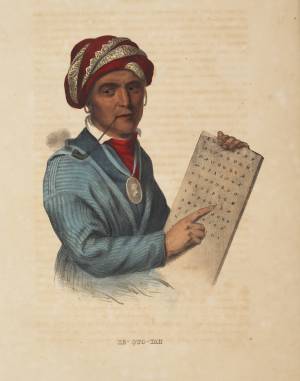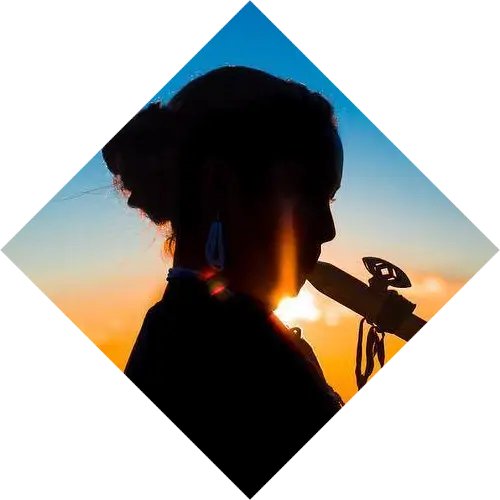If you’ve visited the Museum of the Cherokee People in Cherokee, NC, within the last 30 years, you probably noticed a massive 22-foot tall wooden bust of Sequoyah just outside the building’s entrance. Its beauty and magnificence are hard to miss! But do you know the story of why a Hungarian-born American felt called to sculpt this statue—and a similar one in each of the 50 states— for free?

Sequoyah: A Cherokee Hero
This statue stands as a reminder of Sequoyah’s legacy in the history of the Cherokee people. Created from a single giant California Sequoia log, this carving depicts an elderly Sequoyah with a pendant and headwrap with tall feather. On his face are three carved tears that represent the beginning of the Trail of Tears, the forced and brutal relocation of approximately 100,000 indigenous people living between Michigan, Louisiana, and Florida to land west of the Mississippi River in the 1830s. Among them were about 16,000 Cherokee.
As guests will learn from displays inside the Museum, Sequoyah was an amazing Cherokee silversmith who developed the Cherokee Syllabary. This man—known by several names: Sogwali in Cherokee, George Guess/Gist to white people, and Sequoyah to missionaries—was born around 1770 in present-day Loudon County, Tennessee, to a Cherokee mother and white fur-trading father who left the family when Sequoyah was very young.
After the death of his mother in 1800, Sequoyah ran the trading post that they opened together. He taught himself to make jewelry and worked as a trader for two years before being introduced to silversmithing. To establish his trade, he moved to present-day northeast Alabama.
While he never learned to read or write English, Sequoyah was exposed to written communication among white people (Native Americans called these papers “talking leaves”). He knew that the power of white people was fueled by their ability to communicate through the written word, and saw it as a critical step for Cherokee people. Sequoyah decided to develop a Cherokee writing system. He began working on it in 1809 and it took him about 12 years to complete the syllabary. He spent many hours working alone, isolated from the community. Some believed he was participating in witchcraft.
During the War of 1812, Sequoyah was among many Cherokee who enlisted in the United States armed forces. He was a warrior in the Battle of Horseshoe Bend in 1813, under General Andrew Jackson, against the British troops and Creek Indians. While serving, Sequoyah saw the white warriors writing letter homes. He felt even more convinced that the writing system was going to help his people.
The syllabary had 86 symbols, each representing a sound in the language. He taught his daughter, Ayoka. When it was ready, he introduced it to the Cherokee and in many cases had to convince them that it was useful. Leaders eventually adopted it in 1821. It wasn’t long before there was a Cherokee newspaper (the first Indian newspaper published in the country) and the Bible was translated into Cherokee. Sequoyah moved to Oklahoma in 1828 and passed away in 1843.
Visiting Cherokee is like returning home to so many—a place of peace, calm, magic, and stunning natural beauty. Nestled just outside of the Great Smoky Mountains National Park in a region that’s world-renowned for its diversity of plant and animal life, Cherokee offers so many great places to get outside and enjoy nature, both in town and close by. Whether you’re planning a day trip, weekend getaway, or week-long vacation, you’ll definitely want to get outside and explore the beauty of these ancient mountains.
Choose your own adventure: waterfalls, scenic overlooks, creeks, streams, and wildflowers are all within reach! To help you plan your next outdoor experience, we put together this guide of 15 hikes organized by driving distance. So, how far do you want to go? You decide! Each hike is rated for difficulty, so you know what’s ahead, although most fall in the “easy” or “moderate” categories, making them great options for the whole family.
Many thanks to Livia Lambert for contributing her trail research to help us craft this guide.

The Trail of the Whispering Giants
In February 1972, at age 24, Hungarian-born American sculptor Peter “Wolf” Toth (on left) finished his first monumental stone Indian bust from a cliff in La Jolla, California. It was the first time this self-taught artist ever done anything like this. That summer, after he switched to wood and completed a second bust, he had the epiphany: “I will make a sculpture of an Indian, to honor them, in each of the 50 states.” (Photo by BMWbikerBob)
According to his bio, Peter was one of 11 children born in the newly formed Republic of Hungry in 1947, which was marked by injustice and violence. His father had been driven from his own land by the Communists twice. During the 1956 uprising, the Hungarian borders were open and his family saw the chance to flee. After two years of refugee camps, the Toth family immigrated to the United States, in Akron, Ohio.
Peter had a deep interest in Native American culture and saw similarities between their history and his experience growing up surrounded by hardship in Hungary. He called his collection of representative sculptures of Native Americans the Trail of the Whispering Giants and accepted no payment for them. He said, “I am protesting against the plight of the Indian, against the theft and trickery through which we took this land. We left them with barren waste to suffer poverty and prejudice. But my protest is constructive…one of giving, not destruction. I also want to honor the Indian as the proud and brave people they are.”
In May 1988, after traveling across the country, he met his goal of a statue is every state. Some states even have two! He has also placed statues in other countries, including Canada and Hungary. He made a living selling other sculpted items and working odd jobs. Today, the project remains ongoing as Peter has found a calling to “provide memorials to the indigenous peoples of the World.” He also replaces and reconditions statues in the States.
The syllabary had 86 symbols, each representing a sound in the language. He taught his daughter, Ayoka. When it was ready, he introduced it to the Cherokee and in many cases had to convince them that it was useful. Leaders eventually adopted it in 1821. It wasn’t long before there was a Cherokee newspaper (the first Indian newspaper published in the country) and the Bible was translated into Cherokee. Sequoyah moved to Oklahoma in 1828 and passed away in 1843.
Visiting Cherokee is like returning home to so many—a place of peace, calm, magic, and stunning natural beauty. Nestled just outside of the Great Smoky Mountains National Park in a region that’s world-renowned for its diversity of plant and animal life, Cherokee offers so many great places to get outside and enjoy nature, both in town and close by. Whether you’re planning a day trip, weekend getaway, or week-long vacation, you’ll definitely want to get outside and explore the beauty of these ancient mountains.
Choose your own adventure: waterfalls, scenic overlooks, creeks, streams, and wildflowers are all within reach! To help you plan your next outdoor experience, we put together this guide of 15 hikes organized by driving distance. So, how far do you want to go? You decide! Each hike is rated for difficulty, so you know what’s ahead, although most fall in the “easy” or “moderate” categories, making them great options for the whole family.
Many thanks to Livia Lambert for contributing her trail research to help us craft this guide.
It took Peter four months to hand carve his 63rd statue—the homage to Sequoyah outside the entrance to the Museum of the Cherokee Indian. According to DocSouth, the inscription reads:
SEQUOYAH / THIS STATUE HONORING SEQUOYAH, THE CHEROKEE GENIUS WHO / INVENTED THE CHEROKEE ALPHABET, WAS SCULPTED FROM A SINGLE / GIANT CALIFORNIA SEQUOIA (REDWOOD) LOG WHICH WAS / DONATED AND SHIPPED BY GEORGIA-PACIFIC.
THIS IS SCULPTOR WOLF TOTH’S 63RD STATUE ACROSS THE / UNITED STATES AND CANADA COMMEMORATING THE / CONTRIBUTIONS OF NATIVE AMERICANS. TOTH WAS INVITED TO / SCULPT THE SEQUOYAH STATUE BY CHIEF ROBERT S. YOUNGDEER / AND MUSEUM DIRECTOR KEN BLANKENSHIP.
DEDICATED: SEPTEMBER 30, 1989





